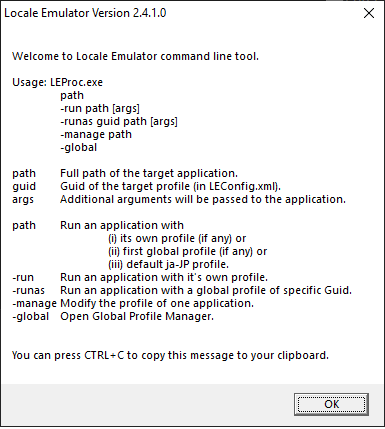

- #Create a shortcut to run with locale emulator android#
- #Create a shortcut to run with locale emulator software#
- #Create a shortcut to run with locale emulator download#
- #Create a shortcut to run with locale emulator free#
# If using CCM to manage Chocolatey, add the following: $ChocolateyDownloadUrl = "$($NugetRepositoryUrl.TrimEnd('/'))/package/chocolatey.0.12.1.nupkg"
#Create a shortcut to run with locale emulator download#
# This url should result in an immediate download when you navigate to it # $RequestArguments.Credential = $NugetRepositor圜redential

#Create a shortcut to run with locale emulator free#
# ("password" | ConvertTo-SecureString -AsPlainText -Force) Locale Emulator is a free open source program for Microsoft Windows devices to run programs in a locale other than the default locale of the operating system. # If required, add the repository access credential here $NugetRepositoryUrl = "INTERNAL REPO URL" # Should be similar to what you see when you browse Your internal repository url (the main one). # We use this variable for future REST calls.

::SecurityProtocol = ::SecurityProtocol -bor 3072 # installed (.NET 4.5 is an in-place upgrade). NET 4.0, even though they are addressable if. # Use integers because the enumeration value for TLS 1.2 won't exist # Set TLS 1.2 (3072) as that is the minimum required by various up-to-date repositories. # We initialize a few things that are needed by this script - there are no other requirements. # You need to have downloaded the Chocolatey package as well. Finally, fill in the meta information of the app being. Click on an appropriate category (e.g., Utilities) under which you want to create a shortcut, and click on New Item button on the top. Download Chocolatey Package and Put on Internal Repository # First, right-click on kickoff icon located at the left bottom corner of your desktop, and then choose Edit Applications menu. # repositories and types from one server installation. # are repository servers and will give you the ability to manage multiple
#Create a shortcut to run with locale emulator software#
# Chocolatey Software recommends Nexus, Artifactory Pro, or ProGet as they # generally really quick to set up and there are quite a few options. # You'll need an internal/private cloud repository you can use. Internal/Private Cloud Repository Set Up # # Here are the requirements necessary to ensure this is successful. Your use of the packages on this site means you understand they are not supported or guaranteed in any way. Select the desired batch file and then select OK. Select Open from the File menu in the Create/Modify Batch File window. With any edition of Chocolatey (including the free open source edition), you can host your own packages and cache or internalize existing community packages. Run the batch file from the Run command line: drive:pathPCSBAT.EXE drive:pathxxxx.BCH /R Note: To run a batch file, specify the /R option. In the file explorer, hold the Shift key on your keyboard and right-click on the empty space. As you can see, I’ve placed my SDK folder in some other drive. Inside the SDK folder, find and open the Emulator folder.
#Create a shortcut to run with locale emulator android#
First, open the file explorer and go to the Android SDK folder. Packages offered here are subject to distribution rights, which means they may need to reach out further to the internet to the official locations to download files at runtime.įortunately, distribution rights do not apply for internal use. Start AVD Manager Without Android Studio. If you are an organization using Chocolatey, we want your experience to be fully reliable.ĭue to the nature of this publicly offered repository, reliability cannot be guaranteed. Profiles can be created using either a path or a source, as well as a set of optional arguments. This will add a new entry to your settings that can be tweaked manually in your settings.json file. But running every time android studio will make the system slow for low configuration computers. To create a new profile, run the Terminal: Select Default Profile command and activate the configure button on the right side of the shell to base it on.


 0 kommentar(er)
0 kommentar(er)
